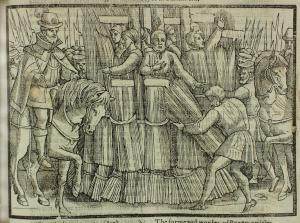Of the burnings which took place in England between 1529 and 1558 by far the largest number occurred in one small area of London – the area known as (West) Smithfield. Just outside the City walls though still within its bounds, not far from Newgate prison, ten minutes’ walk from both the Guildhall and St Paul’s Cathedral on Ludgate Hill (the old pre-Fire of London cathedral, over 600 feet in length and with a spire rising to some 500 feet), this was a convenient place to take people to die, with space enough to erect viewing stands from which ‘the great and the good’ could watch the spectacle. Smithfield, originally known as ‘Smoothfield’, had been a place of public execution for over 400 years; many witches and heretics had been burnt, roasted or boiled alive there. It was here that the Scottish hero and patriot, Sir William Wallace, was hanged, drawn and quartered in 1315, and where Wat Tyler, the leader of the Peasants’ Revolt, was fatally stabbed by the Lord Mayor in 1381. Many tournaments had also taken place there, royal jousts having begun in Smithfield in the reign of Edward III (1327–77). The other activity for which the area was (and is) famous was the craft of butchery, meat having been traded in Smithfield since the tenth century.
Adjacent to the open space of Smithfield was the great Augustinian Priory of St Bartholomew, one of the City’s most important monasteries. The annual Bartholomew Fair was held on the priory’s land, attracting all manner of people – cloth merchants from all around Europe mingling with jugglers, acrobats, innkeepers and pickpockets. It was also an area which drew the poor and the sick, the monastery’s sister-foundation, St Bartholomew’s Hospital (still world-famous as ‘Barts‘), offering relief for the body while the prior and canons (as the members of an Augustinian community were known) offered prayers for the soul.
Of the 288 people estimated to have been burnt for heresy during the five-year reign of Mary Tudor, forty-eight were burnt in Smithfield. The next-highest numbers were eighteen in Lewes in Sussex, seventeen in Stratford-atte-Bow (now Bow in East London), fourteen in Canterbury and seven in Maidstone (both these latter in the county of Kent). Some seventeen people had suffered the same fate in Smithfield under Henry VIII, as had two ‘Anabaptists‘ (extremists whom even Protestants regarded as heretics) during the brief reign of Edward VI.
However interesting and harrowing, the lives and deaths of individual ‘martyrs’ (and the meanings of that emotive word will be considered in due course), my hope is that this book will be more than a compilation of biographies. During the time I have been working on it, the questions that the stories of the Smithfield martyrs provoke have become ever more pertinent, the need for answers (if any exist) ever more urgent. What is it that makes people kill other people in the name of religion? Why are some people prepared to die – or kill – for their beliefs, while the rest of us are content to muddle along with compromise and uncertainty? What led to this ‘burning time’ in the history of England? Could it have been avoided and how was it overcome? Could it happen again? And, most importantly, is there anything we can learn from this dark period in our history to help bring an end to today’s deathly religious conflicts – or are we doomed to go on repeating the same mistakes, in different parts of the world, until we finally succeed in annihilating humankind altogether? The instances of heroism that emerge from the stories of the martyrs, the occasional glimpses of a different kind of light from that produced by flames, suggest it is worth struggling on …
Read more in The Burning Time.



